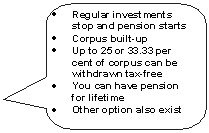|
|
| Help | |
| You are here: Rediff Home » India » Business » Special » Features |
|
| |||||||||||||||||||||||
|
| |||||||||||||||||||||||
It is a happy combination. Pension plans from life insurance companies not only help you save for retirement, but also help create regular retirement income from the accumulated sum (see Pension Plan Demystified). Tax deductions make them a potent investment tool - investments up to Rs 100,000 qualify for deductions under Section 80C.
Evaluate the investment proposition. For long, pension plans have been sold primarily as a tax-saving tool that provided life insurance. The practice still continues. Since you can get a cost-effective cover from term plans, opt only for pure pension plans. With retirement life in India, on an average, stretching to more than two decades, pension investing is becoming crucial.
Also, with a large choice of pension plans, all offering tax deductions, it is important that investment prospects of pension plans are compared.
Participatory policies: security's flip side. Till a few years back, most pension plans were with-profit or bonus-based. In such plans, the insurers bear the investment risk. Your investment is not at risk, and your returns vary with the profits and surplus, depending on the investment performance of the insurer. But the flip side is that these policies don't disclose the investment performance and the costs incurred on fund management or administration.
So, you make do with what is offered. Also, since such plans don't invest in equities, which typically provide high returns in the long term, their returns are in the range of eight per cent.
Participatory policies might work for extremely risk-averse people with low income. It may even work for those who want to use it to create a base retirement income, supplemented by income from other sources. But, most of us need the equity exposure that unit-linked pension plans provide.
The unit-linked advantage. In the past three to four years, life insurers, especially private players, have been launching unit-linked plans. They are becoming popular due to their features that provide flexibility (see Pension Plan Demystified).
In a ULPP, you have to manage the investment risk yourself. Therefore, if retirement is quite some distance away, it makes sense to take higher risk options in such plans, especially exposure to equities.
Of course, in this backdrop, you won't be able to put a finger on what you will end up with. Therefore, it becomes important to carefully evaluate the plans based on various parameters (see Unit Linked Pension Plans).
ULPPs. The amount of money that a person invested in a ULPP, and will end up with during retirement depends on three factors - costs such as those for management and administration, fund management performance and the market growth over the years.
Costs are important as they eat into your premium contribution before the remainder can be invested. Thus, the lower the costs, the better the chances of higher accumulation.
Various companies structure or spread the costs differently during the tenure of their plan. The structuring may even differ with plans from the same company.
Out of the three factors, while fund management and market growth are prospective in nature and beyond your control, you can research on the cost structure of various ULPPs - information that the insurance advisor can give you - before you invest.
Given the cost structure, you can project the retirement corpus you will need at the get at the end of the tenure. Since most of the ULPPs right now have a very short track record, it makes sense to supplement it with the fund performance to find out whether the company can really deliver on its projections (see Growth and Returns).
An important point to remember here is to factor in the equity exposure since it makes a difference to the returns. For instance, while Aviva has a maximum equity exposure of 60 per cent; it is 100 per cent for HDFC Standard Life.
Considering plans with the highest equity exposure from six top life insurers (in terms of their market share), we find that among plans with 100 per cent equity exposure, HDFC Standard Life's plan comes right on top with the best projected value.
It has shown consistency in returns and has the maximum exposure to equities. Of the two other companies providing plans with lower equity exposure, the choice is not a clear one.
By now, it will be clear to you that in the future, you will have to do much more than just take the easy route of investing in a pension plan to save taxes. You will have to take an informed decision on the prospects.
With the right amount of homework, you can ensure that you get a lot of happiness out of the happy combination pension plans provide.
Unit-Linked Pension Plans | ||||
Built-in Flexibility | Age at | Term/ | ||
| Vesting (Yrs) | Deferment (Yrs) | ||
Available Plans | Min. | Max. | Min. | Max. |
HDFC Standard life Unit Linked Pension | 50 | 75 | 10 | 40 |
ICICI Pru. Life Time Super Pension | 45 | 75 | 10 | 57 |
SBI Life Horizon II Pension | 50 | 70 | 10 | 52 |
Met Advantage Plus | 45 | 55 | 10 | 50 |
Aviva life Insurance-Pension Plus | 40 | 70 | 5 | 70 |
Max New York Life-Lifemaker | 50 | 70 | 5 | 52 |
|
|
|
|
|
| Returns | Annualised | Projected | Max. Equity |
| over 1-year1 (%) | return2(%) | corpus3 (Rs) | Exposure (%) |
HDFC Standard Life Unit-Linked Pension | 36.46 | 39.2 | 51.38 lakh | 100 |
ICICI Prudential Life Time Super Pension | 38.06 | 40.08 | 45.38 lakh | 100 |
SBI Life Horizon II Pension | 46.61 | 132.44 | 46.39 lakh | 100 |
Met Advantage Plus | 38.44 | 38.25 | 45.92 lakh | 100 |
Aviva life Insurance - Pension Plus | 16.75 | 24.59 | 44.42 lakh | 60 |
Birla Sunlife Flexi SecureLife Retirement Plan-II | 16.18 | 14.29 | 51.21 lakh | 35 |
Plans of companies launched till April 2003 with top market share considered. 1As on 19 January 2007, except for Aviva, which is till 16 January 2007 | ||||
| PENSION PLAN DEMYSTIFIED | |||||||||||||||||||||||||
 |
|  | |||||||||||||||||||||||
More Specials
Powered by

|
|
| © 2007 Rediff.com India Limited. All Rights Reserved. Disclaimer | Feedback |



